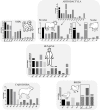Molecular Epidemiology of Blastocystis sp. in Various Animal Groups from Two French Zoos and Evaluation of Potential Zoonotic Risk
- PMID: 28060901
- PMCID: PMC5217969
- DOI: 10.1371/journal.pone.0169659
Molecular Epidemiology of Blastocystis sp. in Various Animal Groups from Two French Zoos and Evaluation of Potential Zoonotic Risk
Abstract
Blastocystis sp. is a common intestinal parasite infecting humans and a wide range of animals worldwide. It exhibits an extensive genetic diversity and 17 subtypes (STs) have thus far been identified in mammalian and avian hosts. Since several STs are common to humans and animals, it was proposed that a proportion of human infections may result from zoonotic transmission. However, the contribution of each animal source to human infection remains to be clarified. Therefore, the aim of this study was to expand our knowledge of the epidemiology and host specificity of this parasite by performing the largest epidemiological survey ever conducted in animal groups in terms of numbers of species screened. A total of 307 stool samples from 161 mammalian and non-mammalian species in two French zoos were screened by real-time PCR for the presence of Blastocystis sp. Overall, 32.2% of the animal samples and 37.9% of the species tested were shown to be infected with the parasite. A total of 111 animal Blastocystis sp. isolates were subtyped, and 11 of the 17 mammalian and avian STs as well as additional STs previously identified in reptiles and insects were found with a varying prevalence according to animal groups. These data were combined with those obtained from previous surveys to evaluate the potential risk of zoonotic transmission of Blastocystis sp. through the comparison of ST distribution between human and animal hosts. This suggests that non-human primates, artiodactyls and birds may serve as reservoirs for human infection, especially in animal handlers. In contrast, other mammals such as carnivores, and non-mammalian groups including reptiles and insects, do not seem to represent significant sources of Blastocystis sp. infection in humans. In further studies, more intensive sampling and screening of potential new animal hosts will reinforce these statements and expand our understanding of the circulation of Blastocystis sp. in animal and human populations.
Conflict of interest statement
Competing Interests: C. Noël is employed by Geneius Laboratories Ltd., RM and SB by the zoo of Lille and TP by the zoo of La Palmyre. There are no patents, products in development or marketed products to declare in relation with our study. This does not alter our adherence to all the PLOS ONE policies on sharing data and materials, as detailed online in the guide for authors.
Figures


Similar articles
-
Prevalence and subtype distribution of Blastocystis sp. isolates from poultry in Lebanon and evidence of zoonotic potential.Parasit Vectors. 2018 Jul 4;11(1):389. doi: 10.1186/s13071-018-2975-5. Parasit Vectors. 2018. PMID: 29973261 Free PMC article.
-
First report on the prevalence and subtype distribution of Blastocystis sp. in dairy cattle in Lebanon and assessment of zoonotic transmission.Acta Trop. 2019 Jun;194:23-29. doi: 10.1016/j.actatropica.2019.02.013. Epub 2019 Mar 13. Acta Trop. 2019. PMID: 30878470
-
Prevalence and genetic diversity of the intestinal parasites Blastocystis sp. and Cryptosporidium spp. in household dogs in France and evaluation of zoonotic transmission risk.Vet Parasitol. 2015 Nov 30;214(1-2):167-70. doi: 10.1016/j.vetpar.2015.09.015. Epub 2015 Sep 14. Vet Parasitol. 2015. PMID: 26395822
-
Blastocystis phylogeny among various isolates from humans to insects.Parasitol Int. 2016 Dec;65(6 Pt B):750-759. doi: 10.1016/j.parint.2016.04.004. Epub 2016 Apr 16. Parasitol Int. 2016. PMID: 27091546 Review.
-
Current status of Blastocystis sp. in animals from Southeast Asia: a review.Parasitol Res. 2020 Nov;119(11):3559-3570. doi: 10.1007/s00436-020-06828-8. Epub 2020 Sep 20. Parasitol Res. 2020. PMID: 32951145 Free PMC article. Review.
Cited by
-
Next-generation sequencing reveals wide genetic diversity of Blastocystis subtypes in chickens including potentially zoonotic subtypes.Parasitol Res. 2021 Jun;120(6):2219-2231. doi: 10.1007/s00436-021-07170-3. Epub 2021 Apr 27. Parasitol Res. 2021. PMID: 33904983
-
Molecular Epidemiology and Genetic Diversity of the Enteric Protozoan Parasite Blastocystis sp. in the Northern Egypt Population.Pathogens. 2023 Nov 15;12(11):1359. doi: 10.3390/pathogens12111359. Pathogens. 2023. PMID: 38003823 Free PMC article.
-
Identification and Molecular Characterization of Four New Blastocystis Subtypes Designated ST35-ST38.Microorganisms. 2022 Dec 23;11(1):46. doi: 10.3390/microorganisms11010046. Microorganisms. 2022. PMID: 36677338 Free PMC article.
-
Molecular characterization of Blastocystis sp. in captive wildlife in Bangladesh National Zoo: Non-human primates with high prevalence and zoonotic significance.Int J Parasitol Parasites Wildl. 2019 Nov 19;10:314-320. doi: 10.1016/j.ijppaw.2019.11.003. eCollection 2019 Dec. Int J Parasitol Parasites Wildl. 2019. PMID: 31867211 Free PMC article.
-
Rare Occurrence of Blastocystis in Pet Animals and Their Owners in the Pomeranian Voivodeship in Poland in the Light of Literature Data.J Clin Med. 2022 May 25;11(11):2975. doi: 10.3390/jcm11112975. J Clin Med. 2022. PMID: 35683363 Free PMC article.
References
-
- Stensvold CR, Clark CG. Current status of Blastocystis: a personal view. Parasitol Int. - PubMed
-
- El Safadi D, Cian A, Nourrisson C, Pereira B, Morelle C, Bastien P, et al. Prevalence, risk factors for infection and subtype distribution of the intestinal parasite Blastocystis sp. from a large-scale multi-center study in France. BMC Infect Dis. 2016; 16: 451 10.1186/s12879-016-1776-8 - DOI - PMC - PubMed
MeSH terms
Substances
LinkOut - more resources
Full Text Sources
Other Literature Sources
Medical

